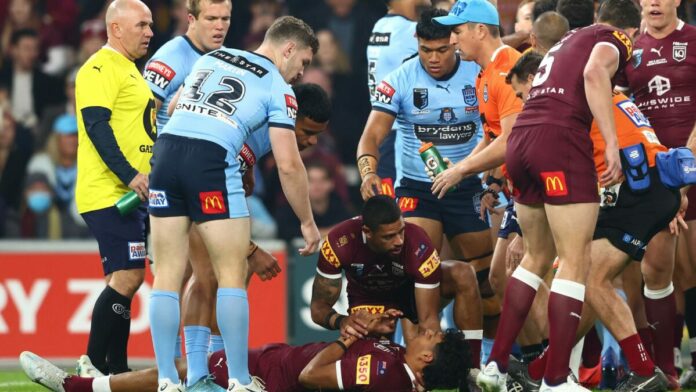
[ad_1]
A
Set small text size
A
Set the default text size
A
Set large text size
The question of whether rugby league is being over-officiated arises amidst increasing measures to reduce dangerous tackles and prevent injuries. This debate hinges on striking a balance between player safety and maintaining the spirit of the game.
In recent years, the sport of rugby league has undergone significant rule changes aimed at prioritising player welfare. Stricter enforcement of high tackles, dangerous contact, crusher tackles, and spear tackles has been implemented to kerb behaviours that risk significant injury.
Harsher sin-bin policies and penalties for high tackles underscore a broader trend of disciplining dangerous actions, reflecting the NRL’s commitment to safety. This shift is supported by injury data, which highlights the prevalence of head injuries and concussions as critical risks.
The Australian Institute of Health and Welfare (AIHW) reported a decline in injury hospitalisations in 2021-22, which includes spinal and neck injuries.
However, these measures are not without controversy. Stricter officiating has led to frequent stoppages for video reviews and penalties, which critics argue disrupt the game’s natural rhythm and excitement, especially during high-stakes matches. Balancing safety with the game’s flow and intensity remains a contentious challenge for administrators.
As the game embraces stricter rules, the debate between player welfare and maintaining its identity intensifies.
Supporters argue that prioritising safety is non-negotiable in a sport known for its high physical toll. With mounting evidence of the long-term effects of concussions, these measures are seen as essential for protecting players.
Advocates insist the rules are not designed to punish but to enforce safer techniques, reflecting the sport’s growing professionalism and its responsibility to lead in player welfare. High-profile lawsuits in other sports highlight the financial and reputational risks of neglecting these concerns.
Reece Walsh reels on the ground as Ben Hunt rushes in to help. (Photo by Cameron Spencer/Getty Images)
On the other hand, critics fear these changes dilute the fabric of rugby league. Automatic sin-bins for high tackles, even when accidental, are seen as overly punitive and at odds with the sport’s tough, physical roots. Fans and players alike express frustration over disrupted game flow and the subjectivity of refereeing decisions, with debates raging over interpretations of “intent” versus “accidental contact”.
The challenge lies in balancing safety with preserving the spectacle and integrity that have long defined the game.
To navigate the fine line between safety and preserving the sport’s identity, rugby league must adopt targeted reforms. Consistency in refereeing is crucial; clearer guidelines and enhanced training can reduce subjective calls and mitigate controversies.
Encouraging input and transparency from players and coaches in rule implementation could align enforcement with gameplay realities. Refining penalties to address reckless behaviour while sparing incidental contact – through a tiered punishment system – would ensure fairness without compromising safety.
Education initiatives promoting safer tackling techniques, alongside streamlined Bunker reviews to minimise game disruptions, would uphold the sport’s pace and physicality. Trialling proposed rule changes in lower divisions or pre-season games can identify potential pitfalls, while periodic reviews incorporating feedback from all stakeholders will ensure rule updates preserve the spirit of the game.
While player safety is non-negotiable, rugby league risks losing its essence if it overcorrects. The challenge lies in fostering a safer environment without over-regulating the physicality that defines the game. Balancing these priorities requires transparent communication, consistent officiating, and thoughtful implementation of rules.
[ad_2]
Copyright for syndicated content belongs to the linked Source link

